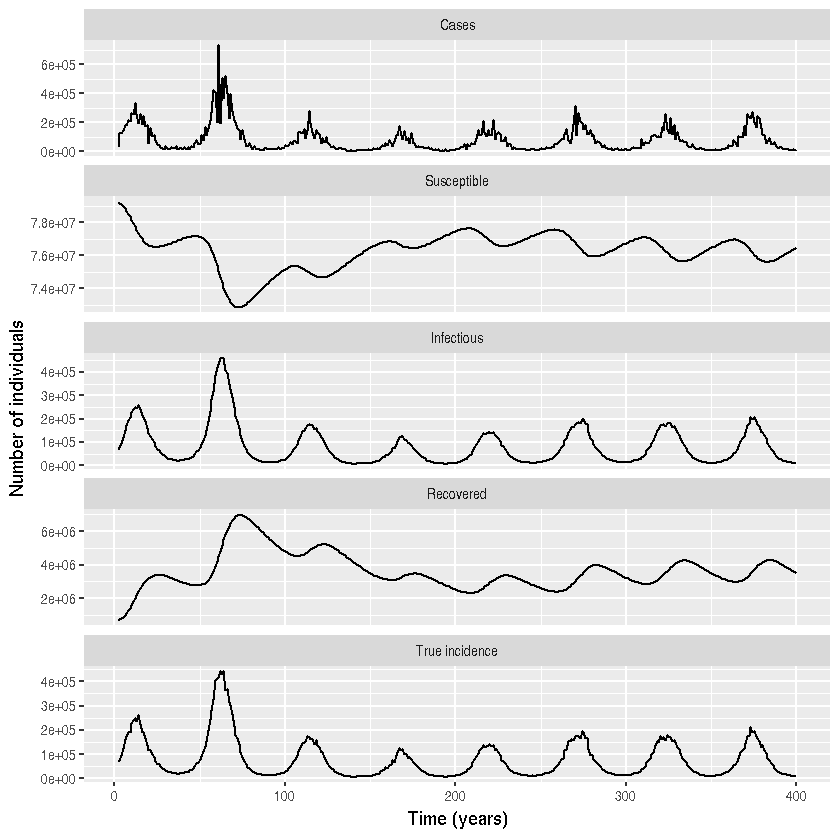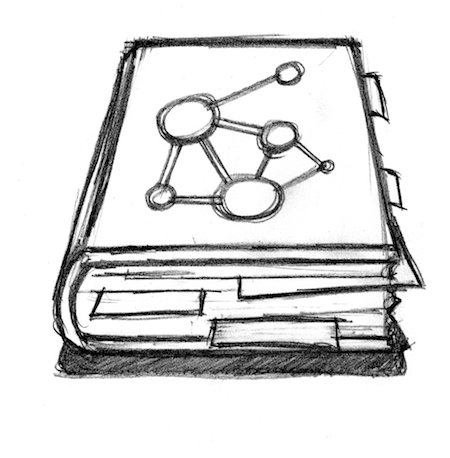Seasonal SIRS model with demographic and extra-demographic noise using POMP (in R)
Author: Theresa Stocks
Date: 2018-10-02
library(pomp)
library(magrittr)
library(plyr)
library(reshape2)
library(ggplot2)
library(scales)
library(dplyr)
# measurement model
dmeas <- Csnippet("lik = dnbinom_mu(cases, 1/od, H, 1); ")
rmeas <- Csnippet("cases = rnbinom_mu(1/od,H);")
# transmission model is Markovian SIRS with 3 age classes, seasonal forcing and overdispersion
sir.step <- Csnippet("double rate[7];
double dN[7];
double Beta1;
double dW;
// compute the environmental stochasticity
dW = rgammawn(sigma,dt);
Beta1 = beta1*(1 + beta11 * cos(M_2PI/52*t + phi)) * dW/dt;
rate[0] = mu*N;
rate[1] = Beta1*I/N;
rate[2] = mu;
rate[3] = gamma;
rate[4] = mu;
rate[5] = omega;
rate[6] = mu;
dN[0] = rpois(rate[0]*dt); // births are Poisson
reulermultinom(2, S, &rate[1], dt, &dN[1]);
reulermultinom(2, I, &rate[3], dt, &dN[3]);
reulermultinom(2, R, &rate[5], dt, &dN[5]);
S += dN[0] - dN[1] - dN[2] + dN[5];
I += dN[1] - dN[3] - dN[4];
R += dN[3] - dN[6] - dN[5];
H += dN[1];
")
# initializer
init <- function(params, t0, ...) {
x0 <- c(S=0,I=0,R=0,H=0)
x0["S"] <- 79807318
x0["I"] <- 3683
x0["R"] <- params["N"] - x0["I"] - x0["S"]
round(x0)
}
# paramter vector with betas and inital data, unit is weeks
params <- c(beta1=1, beta11=0.17, phi=0.1, gamma=1, mu=1/(75*52), N=80000000,
omega=1/(1*52), od=0.1, sigma=0.05)
# create an empty data frame
dat <- data.frame(times=seq(1:400), cases = rep(0, 400))
#pomp object; initalize at t0 before t=0 so system can equilibrate
pomp(data = dat,
times="times",
t0=-100,
dmeasure = dmeas,
rmeasure = rmeas,
rprocess = euler.sim(step.fun = sir.step, delta.t = 1/10),
statenames = c("S", "I", "R", "H"),
paramnames = names(params),
zeronames=c("H"),
initializer=init,
params = params
) -> sir
#simulate one trajectory from the pomp object
df <- simulate(sir, as.data.frame=TRUE, seed=123)
# delete first row of the df because this is the accumulation of cases from t0 until t=0
df <-df[-1,]
# delete the last column of the df because this is the number of simulation
df <- df[,-7]
# plotting the simulated trajectory
df <-df%>% melt(id="time")
df$variable <- factor(df$variable)
df %>% mutate(variable = recode(variable, cases = "Cases")) %>%
mutate(variable = recode(variable, S = "Susceptible")) %>%
mutate(variable = recode(variable, I = "Infectious")) %>%
mutate(variable = recode(variable, R = "Recovered")) %>%
mutate(variable = recode(variable, H = "True incidence")) %>%
ggplot() +
geom_line(aes(x = time, y = value)) +
facet_wrap( ~variable, ncol=1, scales = "free_y")+
xlab("Time (years)") + ylab(" Number of individuals")

